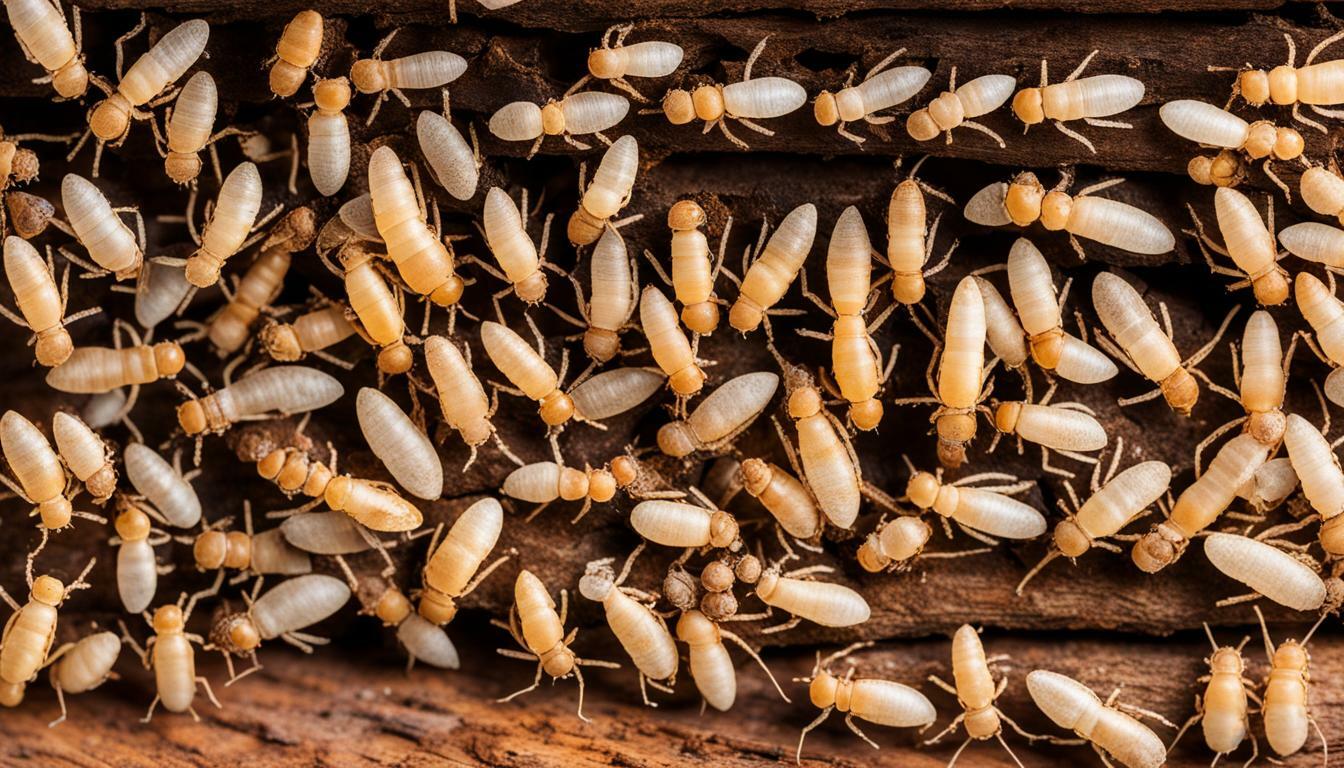
As a professional copywriting journalist, I often get asked how often termite treatment is needed in households. The answer depends on several factors, such as geographical location, climate, and previous infestations. In this section, I will delve into the recommended frequency of termite treatment and provide expert insights to help homeowners maintain a termite-free environment.
Key Takeaways:
- Termite treatment frequency varies based on several factors.
- Regular termite inspections and preventive measures can reduce the need for frequent treatments.
- Recognizing signs of termite infestation is crucial in preventing extensive damage.
Factors Influencing Termite Treatment Frequency
When it comes to termite treatment, the frequency of application varies and depends on several factors. These factors can determine how often you need to take preventative measures to keep termites at bay. Below are the key factors that influence termite treatment frequency:
Geographical Location
The location of your home plays a critical role in determining how often you need termite treatment. Areas with warm and humid climates tend to have a higher risk of termite infestations. Therefore, homes located in such areas require more frequent termite treatment.
Climate
The climate of your area is another factor that affects termite treatment frequency. Humid conditions create moisture that termites are attracted to, making them thrive. On the other hand, areas with dry conditions make it harder for termites to survive. Thus, homes located in humid areas may require more frequent termite treatment.
Previous Termite Infestations
If your home has had a termite infestation before, it is more susceptible to future infestations. Therefore, it is essential to monitor such homes more closely, and termite treatment may need to be applied more frequently.
Construction Materials
The type of construction materials used in your home can also determine the frequency of termite treatment. Houses built with wood frame structures are more vulnerable to termite infestations compared to ones with concrete or steel frames. Consequently, homes built with wood require more frequent termite treatment.
These are the most significant factors that determine the frequency of termite treatment. By understanding these factors, homeowners can determine how often they need to conduct termite treatment to protect their homes from infestations.
Signs That Indicate the Need for Termite Treatment
As a professional copywriting journalist, I have gained extensive experience in identifying the signs of termite infestations. Homeowners must be aware of these signs to address termite problems before they cause severe damage to their property. Here are some of the most common indicators of a termite infestation:
- Mud Tubes: These are pencil-sized tubes made of mud that termites use to travel from their nests to food sources.
- Discarded Wings: Once termites find a suitable location to mate and start a new colony, they shed their wings, which can be found near doors, windows, and other entry points.
- Hollow-Sounding Wood: Termites feed on the inside of wood, leaving the exterior intact, causing the wood to sound hollow when tapped.
- Visible Termite Damage: This can include sagging floors, peeling paint, and buckling wood.
If any of these signs are noticed, it is essential to contact a professional pest control company to conduct a thorough inspection and determine the extent of the infestation. Early detection can prevent costly repairs and damage to your property.
Regular Termite Inspections and Prevention Strategies
Regular termite inspections are a crucial part of preventing termite infestations. By having inspections conducted by a licensed pest control professional, homeowners can detect termites before they cause significant damage. The frequency of inspections depends on various factors, such as the geographical location and the property’s history of infestations.
In addition to inspections, implementing preventive measures can reduce the risk of termite infestations. Homeowners should ensure proper ventilation to reduce moisture, as termites are attracted to damp environments. Removing wood debris from around the property and maintaining a dry environment can also discourage termites.
Another effective way to prevent termite infestations is by utilizing termite control strategies. These strategies may include the use of termite baits, liquid termiticides, or physical barriers. A pest control professional can recommend the best strategy for the specific property and provide guidance on their proper usage.
Overall, regular termite inspections and preventive measures are essential for maintaining a termite-free home. Taking proactive measures can help homeowners avoid costly termite damage, ensuring a safe and pest-free living environment.
Conclusion
In conclusion, maintaining a termite-free home requires homeowners to be proactive in preventing termite infestations and conducting regular inspections. The frequency of termite treatment depends on various factors, such as the location and history of infestations. By staying vigilant and implementing preventive measures, homeowners can reduce the risk of termite damage and ensure a termite-free environment.
Regular termite inspections and prevention strategies are the key to maintaining a termite-free home. Homeowners should ensure proper ventilation, remove wood debris, and maintain a moisture-free environment to prevent termites from accessing their homes. By doing so, homeowners can reduce the chance of termite infestations and the need for frequent termite treatment.
In conclusion, it is essential to prioritize termite prevention and control strategies to avoid significant damage to your property. By being proactive and vigilant, homeowners can maintain a termite-free home and avoid costly termite treatment and repair bills. Remember: prevention is always better than cure when it comes to dealing with termites.
FAQ
Q: How often is termite treatment needed?
A: The recommended frequency for termite treatment in households may vary depending on several factors. It is generally advised to have a professional termite inspection conducted at least once a year to assess the risk of infestation and determine if treatment is necessary. However, in areas with a high prevalence of termites or a history of infestations, more frequent treatments may be required. It is recommended to consult with a local pest control expert to determine the ideal treatment frequency for your specific circumstances.
Q: What factors influence termite treatment frequency?
A: Several factors can influence the frequency of termite treatment. Geographical location plays a significant role, as certain regions have a higher risk of termite infestations. Climate also contributes to termite activity, with warmer and more humid climates creating a more suitable environment for termites. Previous termite infestations in a property can indicate the need for more frequent treatments. Additionally, the construction materials used in a property can affect termite susceptibility. It is important to consider these factors when determining the appropriate treatment frequency.
Q: What are the signs that indicate the need for termite treatment?
A: There are several signs and indicators that suggest the presence of termites and the need for treatment. These signs include the appearance of mud tubes along walls or foundations, discarded termite wings near windows or other entry points, wood that sounds hollow when tapped, and visible damage to wooden structures. If any of these signs are observed, it is crucial to seek professional termite inspection and treatment services promptly.
Q: Why are regular termite inspections and prevention strategies important?
A: Regular termite inspections are essential as a proactive measure to detect termite activity early on and prevent significant damage to a property. By conducting inspections, homeowners can identify potential termite entry points or conditions that are conducive to termite infestations. Implementing prevention strategies, such as proper ventilation, removing wood debris around the property, and maintaining a moisture-free environment, can help reduce the risk of termite infestations. It is recommended to consult with a pest control professional to develop an effective termite prevention plan.
Q: What is the conclusion regarding termite treatment frequency?
A: The frequency of termite treatment depends on various factors, including geographical location, climate, previous infestations, and construction materials. While a general guideline is to have a professional termite inspection conducted annually, more frequent treatments may be necessary in high-risk areas or properties with a history of infestations. Taking proactive measures, such as regular inspections and implementing prevention strategies, is crucial in maintaining a termite-free home. By staying vigilant and working with pest control professionals, homeowners can minimize the risk of termite damage and ensure a termite-free environment.
- Does Flea Treatment Kill Lice? - September 8, 2023
- Does Flea Treatment Kill Mites? - September 8, 2023
- How to Put Flea Treatment on a Dog? - September 8, 2023






